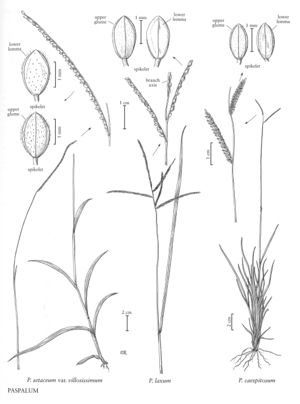Paspalum setaceum var. villosissimum
Common names: Hairy paspalum
Treatment appears in FNA Volume 25.
Plants erect. Leaves conspicuously basal; blades to 15 cm long, 3-10 mm wide, recurved, hirsute, usually with long stiff hairs and short soft hairs, grayish-green, margins ciliate, with long stiff hairs. Panicle branches 2-11.2 cm; branch axes 0.3-0.9 mm wide. Spikelets 1.4-1.9 mm long, 1.1-1.6 mm wide, elliptic, obovate, orbicular, or suborbicular, short pubescent to nearly glabrous, often purple-spotted; lower lemmas without an evident midvein; upper lemmas 1.3-2 mm.
Discussion
Paspalum setaceum var. villosissimum grows in sandy fields and flatwoods of Florida and Cuba. It resembles var. longepedunculatum, differing in its pubescent leaves, more robust habit, and more developed rhizomes.
Selected References
None.
Lower Taxa
None.
... more about "Paspalum setaceum var. villosissimum"
Hairy paspalum +
Conn. +, N.J. +, N.Y. +, Va. +, Del. +, D.C. +, Wis. +, W.Va. +, Ont. +, Fla. +, N.H. +, N.Mex. +, Tex. +, La. +, Tenn. +, N.C. +, S.C. +, Pa. +, Mass. +, R.I. +, Vt. +, Puerto Rico +, Colo. +, Md. +, Ala. +, Ark. +, Ill. +, Ga. +, Ind. +, Iowa +, Ariz. +, Kans. +, Nebr. +, Okla. +, Ohio +, Mo. +, Minn. +, Mich. +, Mont. +, Miss. +, Ky. + and S.Dak. +
Present +
Paspalum setaceum var. villosissimum +
Paspalum setaceum +
variety +
